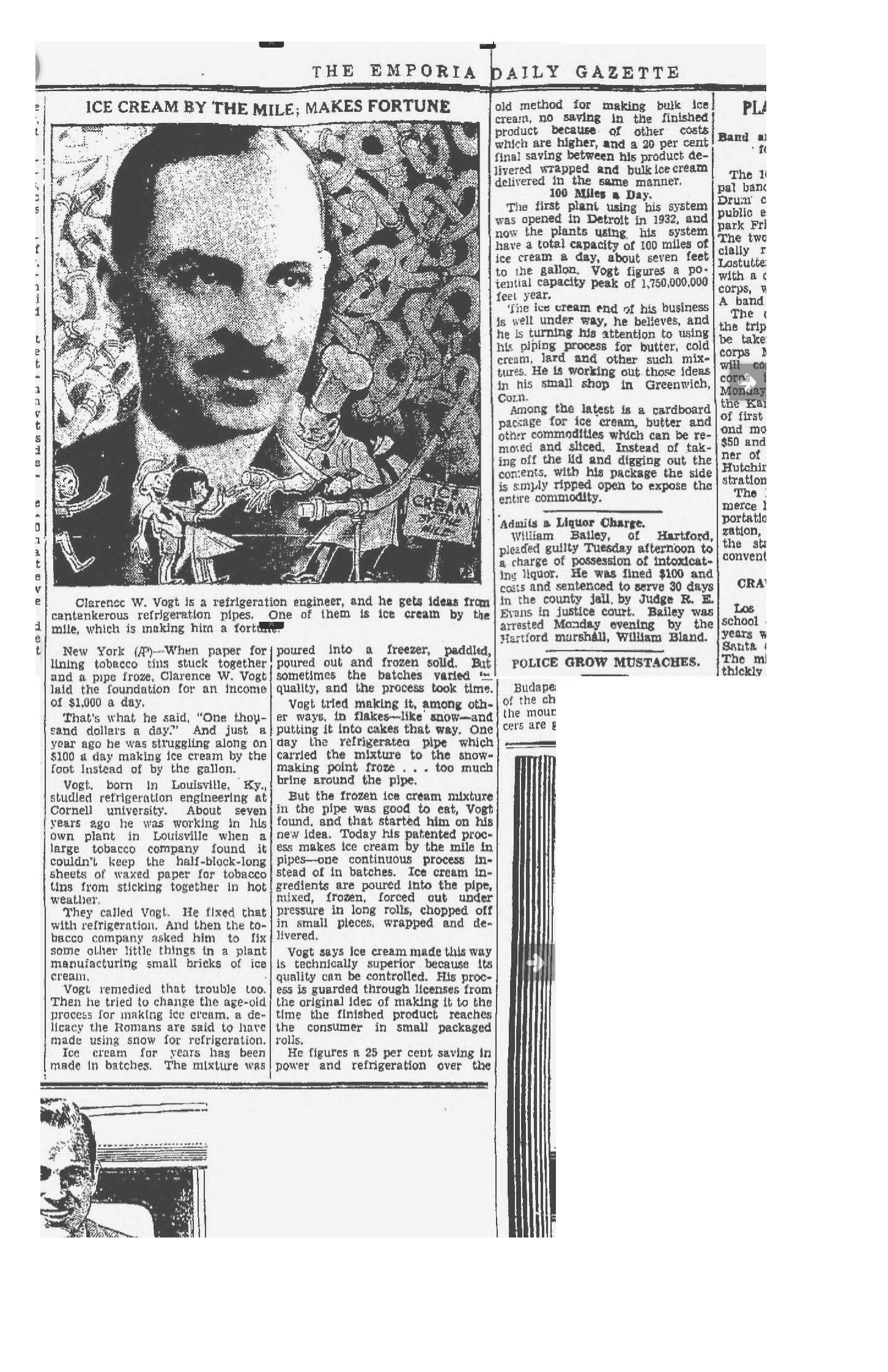In honor of my father’s upcoming 122nd birthday December 30th, here are two new items to add to the published research about his legacy as an inventor: an article I wrote for the Louisville Historical League this summer “Clarence Vogt, Prolific Inventor from Louisville” (click here) which finally tells his story to the folks of his native city, and the following newspaper piece from 1934 wherein a simple breakdown of a manufacturing process appears to have led to the development of his world famous Votator.
As always, thanks to my sister Sarah for all her research and for finding this article.

Emporia Gazette, The (Newspaper) – Wednesday September 12, 1934, Emporia, Kansas
CAPTION: Clarence Vogt is a refrigeration engineer. He gets his ideas from cantankerous refrigeration pipes. One of them is ice cream by the mile, which is making him a fortune.
New York (AP) –
When paper for lining tobacco tins stuck together and a pipe froze, Clarence W. Vogt laid the foundation for an income of $1,000 dollars a day.
That’s what he said, “One thousand dollars a day.” And just a year ago he was struggling along on $100 dollars a day making ice cream by the foot instead of by the gallon.
Vogt, born in Louisville, KY., studied refrigeration engineering at Cornell University. About seven years ago he was working at his own plant in Louisville when a large tobacco company found it couldn’t keep the half-block-long sheets of waxed paper for tobacco tins from sticking together in hot weather.
They called Vogt. He fixed that with refrigeration. And then the tobacco company asked him to fix some other little things in a plant manufacturing small bricks of ice cream.
Vogt remedied that trouble too. Then he tried to change the age-old process for making ice cream, a delicacy the Romans are said to have made using snow for refrigeration.
Ice cream for years has been made in batches. The mixture was poured into a freezer, paddled, and poured out and frozen solid. But sometimes the batches varied in quality, and the process took time.
Vogt tried making it, among other ways, in flakes-like snow- and putting it into cakes that way. One day the refrigerated pipe which carried the mixture to the snow making point froze… too much brine around the pipe.
But the frozen ice cream mixture in the pipe was good to eat, Vogt found, and that started him on his new idea. Today his patented process makes ice cream by the mile in pipes- one continuous process instead of in batches. Ice cream ingredients are poured into the pipes, mixed, frozen, forced out under pressure in long rolls, chopped off in small pieces, wrapped and delivered.
He figures a twenty five percent savings in power and refrigeration over the old method for making bulk ice cream, no savings in the finished product because of other costs which are higher, and a twenty percent final saving between his product delivered wrapped and bulk ice cream delivered in the same manner.
100 Miles a Day
The first plant using his system was opened in Detroit in 1932, and now the plants using his system have a total capacity of 100 miles of ice cream a day, about seven feet to the gallon. Vogt figures a potential capacity peak of 1,750,000,000 feet per year.
The ice cream end of his business is well under way, he believes, and he is turning his attention to using his piping process for butter, cold cream, lard, and other such mixtures. He is working out those ideas in his small shop in Greenwich, Connecticut.
Among the latest is a cardboard package for ice cream, butter, and other commodities which can be removed and sliced. Instead of taking off the lid and digging out the contents, with his package the side is simply ripped open to expose the entire commodity.


Leave a Reply